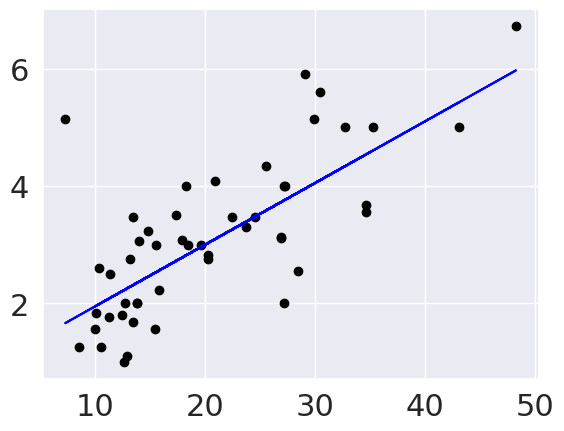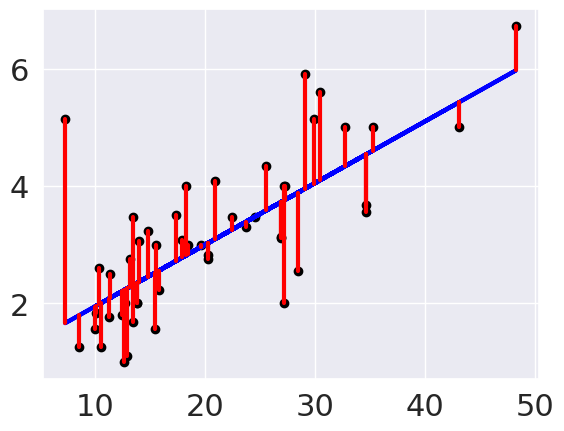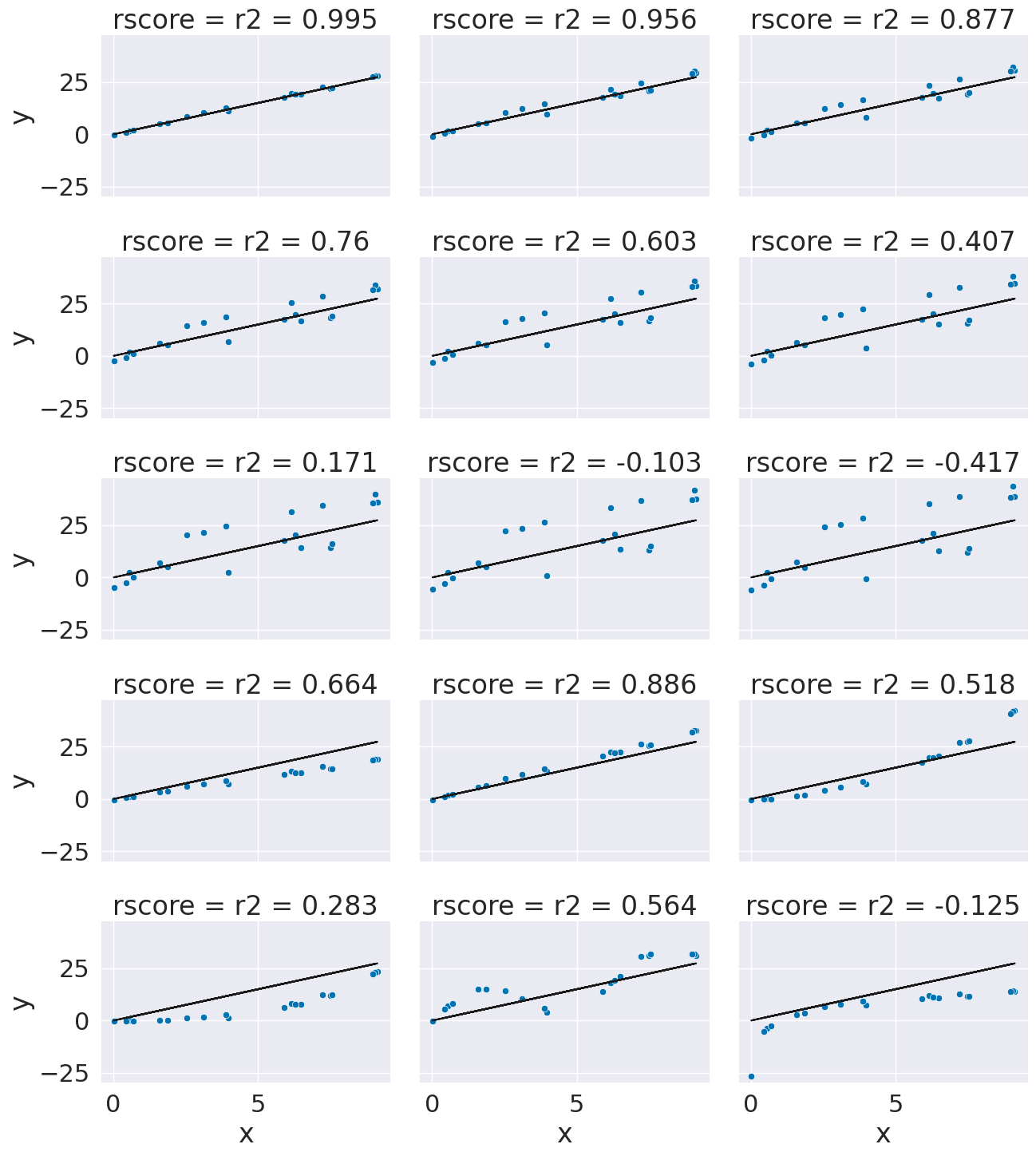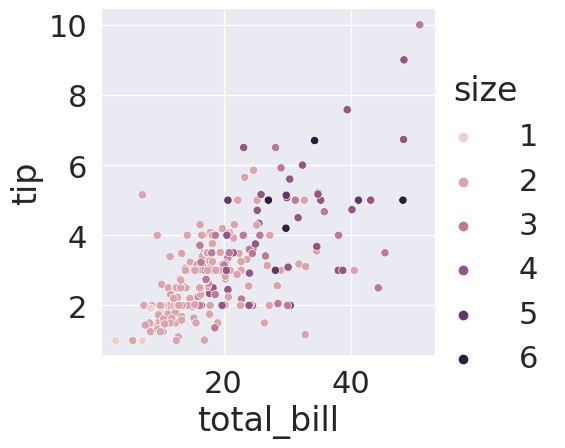19. Regression#
%matplotlib inline
import numpy as np
import seaborn as sns
import matplotlib.pyplot as plt
from sklearn import datasets, linear_model
from sklearn.metrics import mean_squared_error, r2_score
from sklearn.model_selection import train_test_split
import pandas as pd
sns.set_theme(font_scale=2,palette='colorblind')
tips_df = sns.load_dataset('tips')
tips_df.head()
| total_bill | tip | sex | smoker | day | time | size | |
|---|---|---|---|---|---|---|---|
| 0 | 16.99 | 1.01 | Female | No | Sun | Dinner | 2 |
| 1 | 10.34 | 1.66 | Male | No | Sun | Dinner | 3 |
| 2 | 21.01 | 3.50 | Male | No | Sun | Dinner | 3 |
| 3 | 23.68 | 3.31 | Male | No | Sun | Dinner | 2 |
| 4 | 24.59 | 3.61 | Female | No | Sun | Dinner | 4 |
Split the data to use 80% of the data to train a model to predict the tip from the total bill.
tips_X = tips_df['total_bill']
tips_y = tips_df['tip']
type(tips_X.values)
numpy.ndarray
tips_X.values.shape
(244,)
tips_X.values[:,np.newaxis].shape
(244, 1)
tips_X = tips_X.values[:,np.newaxis]
tips_X_train,tips_X_test, tips_y_train, tips_y_test = train_test_split(tips_X, tips_y,
train_size=.8)
regr = linear_model.LinearRegression()
type(tips_X)
numpy.ndarray
regr.fit(tips_X_train,tips_y_train)
LinearRegression()In a Jupyter environment, please rerun this cell to show the HTML representation or trust the notebook.
On GitHub, the HTML representation is unable to render, please try loading this page with nbviewer.org.
LinearRegression()
regr.get_params()
{'copy_X': True, 'fit_intercept': True, 'n_jobs': None, 'positive': False}
regr.coef_
array([0.10513009])
regr.intercept_
0.8998806720394064
tips_y_pred = regr.predict(tips_X_test)
tips_y_pred[0]
2.7838119316826817
tips_X_test[0]*regr.coef_ + regr.intercept_
array([2.78381193])
plt.scatter(tips_X_test,tips_y_test, color='black')
plt.plot(tips_X_test,tips_y_pred, color='blue')
[<matplotlib.lines.Line2D at 0x7f8bc9a9df10>]

plt.plot(tips_X_test, tips_y_pred, color='blue', linewidth=3)
# draw vertical lines frome each data point to its predict value
[plt.plot([x,x],[yp,yt], color='red', linewidth=3)
for x, yp, yt in zip(tips_X_test, tips_y_pred,tips_y_test)];
plt.scatter(tips_X_test, tips_y_test, color='black')
<matplotlib.collections.PathCollection at 0x7f8bc7961f10>

mean_squared_error(tips_y_test,tips_y_pred)
0.8443482832748362
tips_y_test.mean()
3.1446938775510205
mean_squared_error(tips_y_test,tips_y_pred)/tips_y_test.mean()
0.26849935674259834
r2_score(tips_y_test,tips_y_pred)
0.5218612850368313
x = 10*np.random.random(20)
y_pred = 3*x
ex_df = pd.DataFrame(data = x,columns = ['x'])
ex_df['y_pred'] = y_pred
n_levels = range(1,18,2)
noise = (np.random.random(20)-.5)*2
for n in n_levels:
y_true = y_pred + n* noise
ex_df['r2 = '+ str(np.round(r2_score(y_pred,y_true),3))] = y_true
f_x_list = [2*x,3.5*x,.5*x**2, .03*x**3, 10*np.sin(x)+x*3,3*np.log(x**2)]
for fx in f_x_list:
y_true = fx + noise
ex_df['r2 = '+ str(np.round(r2_score(y_pred,y_true),3))] = y_true
xy_df = ex_df.melt(id_vars=['x','y_pred'],var_name='rscore',value_name='y')
# sns.lmplot(x='x',y='y', data = xy_df,col='rscore',col_wrap=3,)
g = sns.FacetGrid(data = xy_df,col='rscore',col_wrap=3,aspect=1.5,height=3)
g.map(plt.plot, 'x','y_pred',color='k')
g.map(sns.scatterplot, "x", "y",)
<seaborn.axisgrid.FacetGrid at 0x7f8bc791e490>

regr.score(tips_X_test,tips_y_test)
0.5218612850368313
tips_df.head()
| total_bill | tip | sex | smoker | day | time | size | |
|---|---|---|---|---|---|---|---|
| 0 | 16.99 | 1.01 | Female | No | Sun | Dinner | 2 |
| 1 | 10.34 | 1.66 | Male | No | Sun | Dinner | 3 |
| 2 | 21.01 | 3.50 | Male | No | Sun | Dinner | 3 |
| 3 | 23.68 | 3.31 | Male | No | Sun | Dinner | 2 |
| 4 | 24.59 | 3.61 | Female | No | Sun | Dinner | 4 |
tips_X2 = tips_df[['total_bill','size']]
tips_X2_train,tips_X2_test, tips_y2_train, tips_y2_test = train_test_split(tips_X2, tips_y,
train_size=.8)
regr2 = linear_model.LinearRegression()
regr2.fit(tips_X2_train,tips_y2_train)
LinearRegression()In a Jupyter environment, please rerun this cell to show the HTML representation or trust the notebook.
On GitHub, the HTML representation is unable to render, please try loading this page with nbviewer.org.
LinearRegression()
regr2.coef_
array([0.09588457, 0.1885609 ])
regr2.score(tips_X2_test,tips_y2_test)
0.43943140371626077
sns.relplot(data=tips_df,x='total_bill',y='tip',
hue='size')
<seaborn.axisgrid.FacetGrid at 0x7f8bc7916dc0>

from sklearn import datasets
# Load the diabetes dataset
diabetes_X, diabetes_y = datasets.load_diabetes(return_X_y=True)
X_train,X_test, y_train,y_test = train_test_split(diabetes_X, diabetes_y ,
test_size=20,random_state=0)
regr_db = linear_model.LinearRegression()
regr_db.fit(X_train, y_train)
LinearRegression()In a Jupyter environment, please rerun this cell to show the HTML representation or trust the notebook.
On GitHub, the HTML representation is unable to render, please try loading this page with nbviewer.org.
LinearRegression()
y_pred = regr_db.predict(X_test)
r2_score(y_test,y_pred)
0.5195333332288746
diabetes_X.shape
(442, 10)
lasso = linear_model.Lasso()
lasso.fit(X_train, y_train)
lasso.score(X_test,y_test)
0.42249260665177746
lasso = linear_model.Lasso(.5)
lasso.fit(X_train, y_train)
lasso.score(X_test,y_test)
0.527228369284263
lasso = linear_model.Lasso(.25)
lasso.fit(X_train, y_train)
lasso.score(X_test,y_test)
0.5501992246861973
lasso.coef_
array([ -0. , -52.1429064 , 503.60281992, 219.24141192,
-0. , -0. , -147.83111493, 0. ,
441.7507385 , 0. ])
link to polynomial regression
